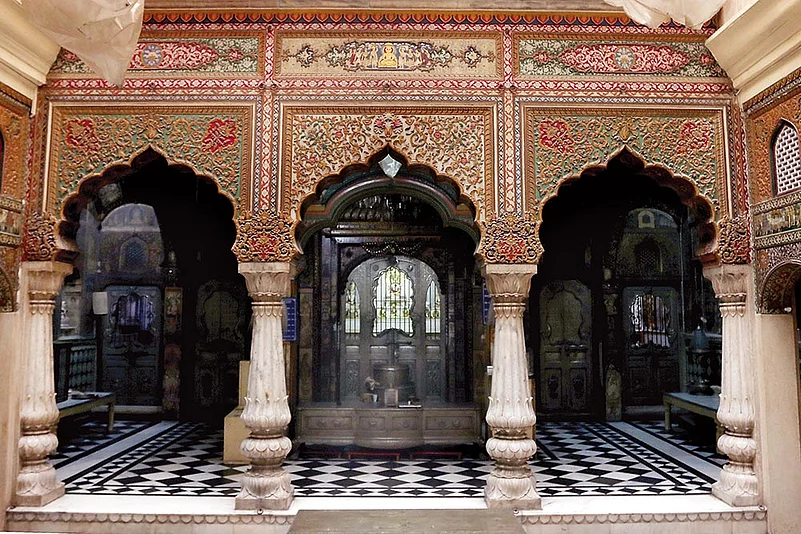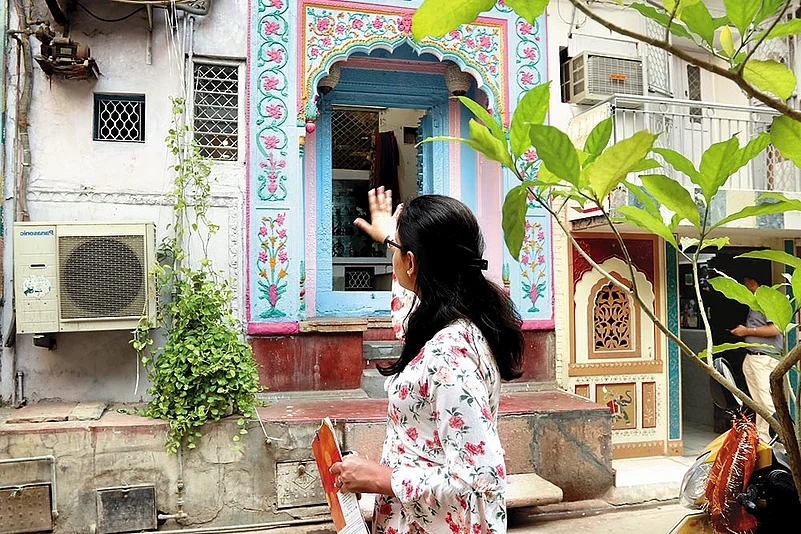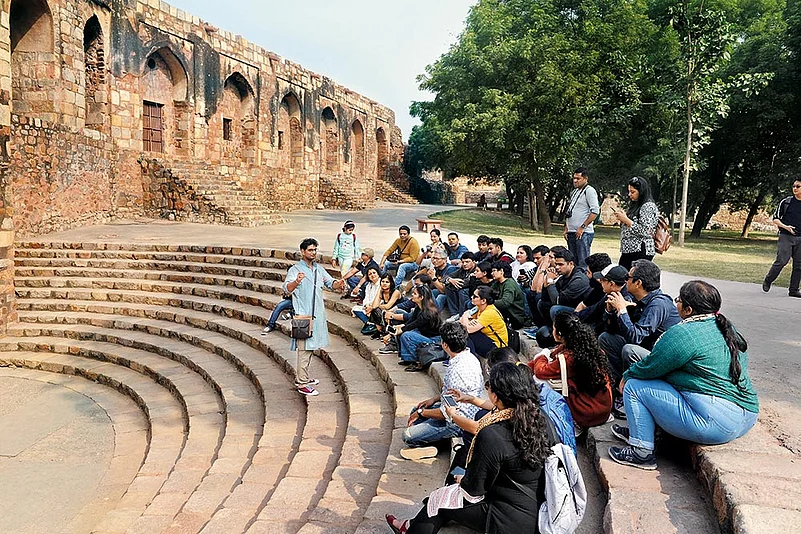Dilli kahan gayee tere kuchon ke raunaqen
Galiyon se sar jhuka ke guzarne laga huun main…
Learning About The Past Through Heritage Walks
Seeing cities with -heritage walkers, adept at both -history and lore

Jaan Nisar Akhtar
The crisscrossing web of overhead wires makes strange designs against a hazy Nov--ember sun. On the lane below is even more chaos. A nonchalant bull stands in the middle, unmindful of the relentless honks. The smell from the halwai shops mix with the garbage rotting by the roadside, close to a hawker selling attar. Chandni Chowk is still the vibrant, pulsating marketplace that Mughal emperor Shah Jahan had envisaged when he had set up ‘Moonlight Square’ in the 17th century. But the lanes and bylanes that make up old Delhi—the loving ‘Dilli’ of Mir Taqi Mir, Ghalib and Zauq—also reflect the anguish of poets. Some of the once-magnificent havelis are almost on the verge of collapse, others have been completely altered. The magnificent pool in the middle of Chandni Chowk, designed by Shah Jahan’s daughter Jahanara, is long gone.
But some signs of the past remain. Some among them, hidden from the cursory glance. And it takes some special eyes to see these hidden del-ights of Mughal Dilli. Or a British Calcutta. Or the Nizam’s Hyderabad. There are some places that ‘Raju guide’ won’t—and can’t—show you. And then you turn to someone like Javeria Tanveer, 25, an MPhil in art history from the National Museum Institute in Delhi and a professional guide. And she guides you through a stunning 16th century Jain temple in the heart of old Delhi, at the cul-de-sac in Gali Naughara, a narrow lane with nine beautiful havelis built by Jains who had settled in the locality during the Mughal period. The shrine mixes traditional Jain architecture with Islamicate design, especially in the murals made of glazed tiles and mirrors. “The architecture you see here, the multi-foliated arches, were especially commissioned by Shah Jahan,” she tells a group -accompanying her.

Javeria Tanveer of India City Walks points at an earthily ornate chaukhat in Delhi’s Chandni Chowk
Tanveer is among a new breed of young Indian history enthusiasts who are sharing their knowledge and expertise with people through guided tours, which have come to be known as ‘heritage walks’. Across towns and cities, these people are creating a genre of tourism that caters to select people who want to learn about the past through the eyes of historians and experts. And there are many who still prefer a ‘live’ tour to putting on VR goggles to go skinny dipping in the Mediterranean. For these enthusiasts, nothing beats an actual historian or archaeologist helping them unearth the trade secrets of the 300-year-old sweet shop -bustling right next door.
After completing her MPhil, Tanveer joined the Delhi-based India City Walks, an organisation une-arthing the heritage of cities one step at a time. “I’ve grown up in old Delhi and have loved every corner of this city. Being an explorer felt like a natural choice after my MPhil,” Tanveer says as she deftly skips away from a flower-ferrying tonga, meandering through a lane that resembles Willy Wonka’s trippy chocolate factory. Sachin Bansal founded the India City Walks after a corporate career that took him jet-setting in business class across golden beaches and azure seas. Since 2013-14, the “exp-lorer” by passion has been designing and curating walks with a team of heritage enthusiasts. His par-tner in this endeavour is his wife Nidhi, who had clocked in close to two decades in the hospitality sector before coming on board the walk-wagon. The couple have managed to map most of the country, including tier two cities, through their innovative wanderings, most often on foot, and at other times on local rickshaws. “An experience is much more than a tour,” says Bansal.
While the traditional guide can still be found traipsing across town with groups of wide-eyed Indian and foreign tourists taking selfies in front of the Taj Mahal, demand for the less-googled gems is steadily on the rise. “I try and always avoid the Golconda fort and take people around it instead,” says a Hyderabad-based explorer who conducts walks almost every weekend. A journalist by profession—the publicity-shy Hyderabadi who does not want his name published has set out on a mission to acquaint fellow-Hyderabadis with the city they live in, and yet, are strangers to. “I honestly got tired of people saying no one does anything about the heritage and culture of the city….I thought, why not do these walks? I conduct them during the early hours of the day when the streets are mostly deserted. I also get experts and archaeologists to talk about particular spots,” he says.

Intricate motifs of the ceiling at the Jain temple at Gali Naughara, Delhi
Most of them do it purely out of their love for antiquity and culture, charging up to Rs 650 per person. “The scheduled walks happen every weekend. Everyone can attend a walk for its duration of one-and-a-half hours for Rs 450, and for two-and-a-half to three hour walks the price is around Rs 650 per person,” says Tathagata Neogi, archaeologist and founder of Heritage Walk Calcutta, which he established in early 2017 with his wife, Chelsea McGill. Neogi set out to create a space for “academics” willing to step out of their comfort zones and “make their research available to the public”. Neogi’s walks are seldom one-sided sermons on Calcutta’s past; they frequently tap into the argumentative soul in the feisty Bengali as well. “Our walk provides the space to talk about the various aspects of an event or debate. We don’t impose any opinion on any one, people just exp-ress what they want to,” Neogi adds as he gears up to do multiple rounds of the National Library and other archives for his walks. One of them is curiously called ‘murder and mayhem’, taking people through infamous spots of notorious killings and giving them a glimpse into Calcutta’s underbelly.
Clearly, this is no child’s play, as one needs to cover miles of historical and factual ground before setting off on one such walk. And as the famous adage asks you to innovate to succeed, India’s young community of heritage walkers seems to take that advice rather seriously. “It’s like conducting storytelling sessions through the lanes of a city. We represent the city in different themes and conduct night walks, ghost walks and even food walks,” says Asif Khan Dehlvi of Delhi Karavan, which has now branched out to include Jaipur, Calcutta, Hyderabad, and will soon launch Lucknow chapters as well. Growing up in Old Delhi, he didn’t quite fit into a corporate organisation as an HR executive. “My manager was always unh-appy with me. She wanted to know why I don’t smile much at work. In reality, I had already taken off to my world of fantasies and djinns whose stories I have grown up on. I ended up quitting my job in 2011 and starting Delhi Karavan,” he says in pure Hindustani. It’s how he chooses to conduct his walks as well. “The 15-odd people on walks with us come from various backgrounds. Most are locals while some have come and settled in Delhi. Some are foreigners as well. While the foreigners don’t understand the language, they enjoy the authentic flavour it brings to a walk,” Dehlvi says.

Delhi Karavan’s Asif Khan Dehlvi explains the wonders of Delhi’s Purana Qilla
From customising the story to fit the audience’s profile, to curating private walks at premium rates, the new-age explorer is more than just a sophisticated version of your friendly old guide—she is a secret-keeper of the breathing city that lives within a concrete metropolis. “It’s more than just buildings. Heritage is the people, the stories. We conduct walks through different parts of every other city that you can think of in India, even Benaras. The idea is to constantly stay updated. We love what we do,” says Soumi Roy of India City Walks. After completing her PhD in history from Jawaharlal Nehru University, Roy found it difficult to escape the charms of the -nomadic life being -offered by her present workplace. “I shifted from teaching in colleges to working with India City Walks full time. It’s a new experience every day. Come to think of it, it’s not too different. The teacher remains the same, only the class keeps changing. Same here,” Roy adds.

Ahmedabad’s Raipur Gate
“I was born and brought up in Delhi, so was my father. Yet, I had to talk to people and ask others about my own city,” says Delhi Karavan’s Sudipta Agarwal. “The reward in this is not in cash but when people come and tell me how I have managed to show them a city they never knew existed before. For instance, did you know that there’s an Ashokan edict in Delhi’s East of Kailash?” While Agarwal simultaneously prepares for a PhD in history of Delhi, she believes her first hand tryst with its formidable legacy has only helped enrich her research. However, she’s not an exception. Juggling his on-campus duties as an English professor at Miranda House, and moonlighting as an expert on the old relics of Delhi, Amit Ranjan finds himself gravitating to Humayun’s Tomb alm-ost every other day, in search of brand new stories. “I’ve conducted several walks with foreigners, -expats and my Australian friends through Sanjay Vann and Humayun’s Tomb. Ten years ago, when I was a journalist, I wrote extensively on the heritage of Delhi. My interest in history goes -beyond my work. I have books coming up on Dara Shikoh and John Lang, the lawyer of Rani of Jhansi,” Ranjan says. The academic conducts his heritage strolls in collaboration with Sahapedia, a non-profit online platform commissioning and curating research in the field of Indian arts and culture. Being a key stakeholder in the field of Indian heritage, Sahapedia has brought on board several academics and experts to conduct their heritage walks across not just mainland India, but also in the Northeast since November 2016. “It’s about making history more relevant. Collaborating with Sahapedia, I have conducted food walks and folk legend walks, among others,” says Duli Ete, assistant professor of history in Itanagar’s Dera Natung College. While trying to destigmatise the job done by traditional guides, often identified as unqualified laymen rattling off tales instead of facts to una-ssuming tourists, the process of curating an information-filled accurate walk also -entails safeguarding such oral traditions. “Truth is relative. The historical sources we have access to are mostly written by the British in which we are the villains. In that case, knowing the local history becomes important,” Ete says.
Back in Old Delhi, as Tanveer points to the brightly coloured facades of the Jain havelis, Mir’s poetic words sound the perfect description of the beauty that Delhi is. But these words also fit any other place with a lane soaked in history. These are not just lanes of Delhi but paintings by artists.




















